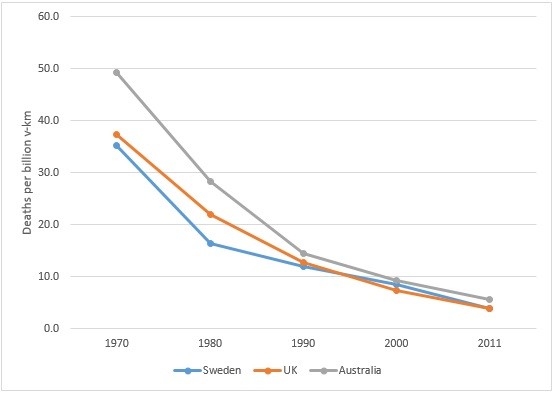
The Economist reported this week that the number of road deaths in Sweden has fallen by four-fifths since 1970. Only three in every 100,000 Swedes die on the roads each year, “compared with 5.5 per 100,000 across the European Union, 11.4 in America and 40 in the Dominican Republic.”
All western countries have reduced road deaths substantially over the last 40 or so years, but Sweden is one of a handful of out-performers. One statistic in particular caught the attention of social media: only one child aged under 7 years died on Swedish roads in 2012, compared with 58 in 1970.
The Economist says Sweden’s success is down to a culture of zero-tolerance for road deaths. The Vision Zero program instituted in 1997 prioritised safety in the design and management of roads over speed or convenience.
That culture translated into initiatives like lower speed limits, separation of cars from pedestrians and cyclists, more overtaking lanes on highways (“2+1” roads), more traffic management infrastructure, tighter regulation (e.g BAC of 0.2), and stronger enforcement.
Unfortunately, The Economist doesn’t compare Sweden’s achievements with other countries. Also, the ratio of fatalities to population is a crude measure of risk because it doesn’t account for differences between countries in road use.
The Road Safety Annual Report 2013 published by the OECD’s International Transport Forum provides comparative road safety statistics for 37 countries. It includes data showing fatalities by both population and, where data’s available, per billion vehicle km (v-km) of road travel.
As expected, Sweden is among the safest places to drive with 3.8 deaths per billion v-km in 2011. Consistent with the idea of a “Northern Europe Effect”, some of its neighbours are also exceedingly safe i.e. Iceland (3.8) and Norway (3.9).
The most dangerous places for driving in 2011 were Korea (17.6) and the Czech Republic (16.2). Nevertheless, these countries have improved enormously compared to earlier decades. As recently as 2000, the death rate in Korea was 49.5.
With 5.6 deaths per billion v-km, Australia does reasonably well in this comparison. Our roads are safer than those in Canada (6.5), the US (6.8) and Japan (7.8).
Australia is also a safer place to drive than some European countries, including Belgium (8.5) and France (7.0), and is as safe as Germany (5.6). In common with other countries in the OECD study, our roads are much safer now than they were in 1970 when there were 49.3 deaths per billion v-kt.
The countries that showed the biggest improvements over 1970-2011 are Japan (96.4 to 7.8), Belgium (104.6 to 8.5) and, especially, Slovenia (166.7 to 7.8).
What surprises me most about the data, though, is the relatively low risk of driving in the United Kingdom and Ireland. Ireland recorded 3.9 deaths per billion v-kt in 2011, making it the fourth safest country of those studied by the OECD.
With 3.9 deaths per billion v-kt in 2011, the UK ranked third, close behind Sweden and Iceland. In terms of deaths per 10,000 registered vehicles, the UK ranked second in the world (after Norway); and in terms of fatalities per capita it ranked first.
Although well-regarded, the UK isn’t commonly seen as at the leading edge of enlightened transport policy. For example, cycling levels are much the same in the UK as they are in Australia according to leading researchers John Pucher and Ralph Buehler.
There are many factors that explain differences in risk between countries e.g. levels of car ownership, urbanisation, congestion, age of vehicle fleet, enforcement policy, and more.
I don’t know why the UK does so well but I doubt it’s entirely or even largely due to the sort of policy intervention implemented in Sweden (theories welcome, please!). It suggests to me that other countries won’t necessarily achieve the same outcome as Sweden by replicating its Vision Zero approach. Other factors appear to matter too.
Indeed, The Czech Republic (16.2), Denmark (4.9), Finland (5.4), Norway (3.9), Poland (no data) and Slovenia (7.8) have all adopted Vision Zero, but of these only Norway has achieved results comparable with Sweden.
It might be that some countries are especially safe for driving because cultural factors predispose the population to accept constraints on their driving behaviour and to support investment in infrastructure.
In other cases though it might be that technical factors like high levels of urbanisation (country driving is especially unsafe everywhere), traffic congestion, emergency care, new vehicles in the national fleet, etc, are the main explanations for a particular country’s relatively low risk of death on the roads.
Historical improvements in road safety in Australia are consistent with progress in comparable countries. Reducing deaths further is an important objective, but it’s likely catching up with Sweden would be very difficult politically.
Yet there’s something seriously wrong in Australia. According to the OECD data, 5 children under the age of six years died on Swedish roads in 2011. The corresponding figure for the UK was 13, which after allowing for population is much better than Sweden. But in Australia it was 39.








Crikey encourages robust conversations on our website. However, we’re a small team, so sometimes we have to reluctantly turn comments off due to legal risk. Thanks for your understanding and in the meantime, have a read of our moderation guidelines.